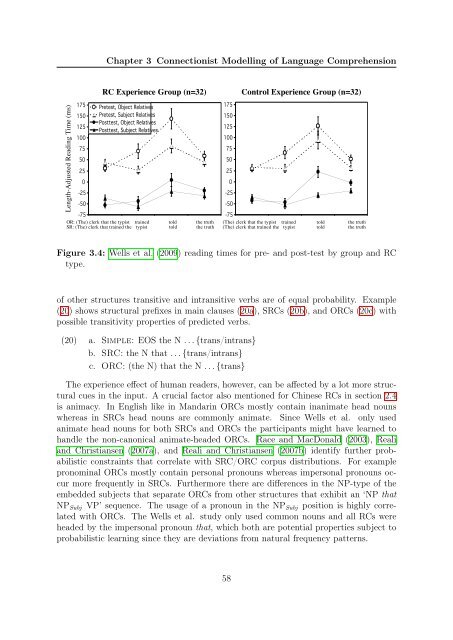Connectionist Modeling of Experience-based Effects in Sentence ...
Connectionist Modeling of Experience-based Effects in Sentence ...
Connectionist Modeling of Experience-based Effects in Sentence ...
Create successful ePaper yourself
Turn your PDF publications into a flip-book with our unique Google optimized e-Paper software.
Length-Adjusted Read<strong>in</strong>g Time (ms)<br />
Chapter 3 <strong>Connectionist</strong> Modell<strong>in</strong>g <strong>of</strong> Language Comprehension<br />
Figure 1: Self-Paced Read<strong>in</strong>g Patterns at Pre- and Posttest<br />
175<br />
150<br />
125<br />
100<br />
75<br />
50<br />
25<br />
0<br />
-25<br />
-50<br />
-75<br />
1 2 3 4<br />
OR: (The) clerk that the typist tra<strong>in</strong>ed told the truth<br />
SR: (The) clerk that tra<strong>in</strong>ed the typist told the truth<br />
36<br />
Relative Clause <strong>Experience</strong><br />
RC <strong>Experience</strong> Group (n=32) Control <strong>Experience</strong> Group (n=32)<br />
Pretest, Object Relatives<br />
Pretest, Subject Relatives<br />
Posttest, Object Relatives<br />
Posttest, Subject Relatives<br />
175<br />
150<br />
125<br />
100<br />
75<br />
50<br />
25<br />
0<br />
-25<br />
-50<br />
-75<br />
1 2 3 4<br />
(The) clerk that the typist tra<strong>in</strong>ed told the truth<br />
(The) clerk that tra<strong>in</strong>ed the typist told the truth<br />
Figure 3.4: Wells et al. (2009) read<strong>in</strong>g times for pre- and post-test by group and RC<br />
type.<br />
<strong>of</strong> other structures transitive and <strong>in</strong>transitive verbs are <strong>of</strong> equal probability. Example<br />
(20) shows structural prefixes <strong>in</strong> ma<strong>in</strong> clauses (20a), SRCs (20b), and ORCs (20c) with<br />
possible transitivity properties <strong>of</strong> predicted verbs.<br />
(20) a. Simple: EOS the N . . . {trans/<strong>in</strong>trans}<br />
b. SRC: the N that . . . {trans/<strong>in</strong>trans}<br />
c. ORC: (the N) that the N . . . {trans}<br />
The experience effect <strong>of</strong> human readers, however, can be affected by a lot more structural<br />
cues <strong>in</strong> the <strong>in</strong>put. A crucial factor also mentioned for Ch<strong>in</strong>ese RCs <strong>in</strong> section 2.4<br />
is animacy. In English like <strong>in</strong> Mandar<strong>in</strong> ORCs mostly conta<strong>in</strong> <strong>in</strong>animate head nouns<br />
whereas <strong>in</strong> SRCs head nouns are commonly animate. S<strong>in</strong>ce Wells et al. only used<br />
animate head nouns for both SRCs and ORCs the participants might have learned to<br />
handle the non-canonical animate-headed ORCs. Race and MacDonald (2003), Reali<br />
and Christiansen (2007a), and Reali and Christiansen (2007b) identify further probabilistic<br />
constra<strong>in</strong>ts that correlate with SRC/ORC corpus distributions. For example<br />
pronom<strong>in</strong>al ORCs mostly conta<strong>in</strong> personal pronouns whereas impersonal pronouns occur<br />
more frequently <strong>in</strong> SRCs. Furthermore there are differences <strong>in</strong> the NP-type <strong>of</strong> the<br />
embedded subjects that separate ORCs from other structures that exhibit an ‘NP that<br />
NPSubj VP’ sequence. The usage <strong>of</strong> a pronoun <strong>in</strong> the NPSubj position is highly correlated<br />
with ORCs. The Wells et al. study only used common nouns and all RCs were<br />
headed by the impersonal pronoun that, which both are potential properties subject to<br />
probabilistic learn<strong>in</strong>g s<strong>in</strong>ce they are deviations from natural frequency patterns.<br />
58
















